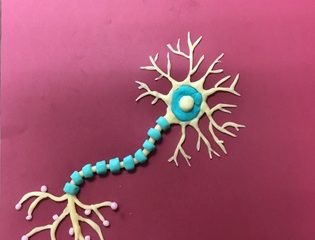Last week, our Sensation/Perception class had lemon jello day. If this sounds insidious, I assure you it’s just a bunch of fun. Here’s the deal. We whip up a batch of lemon jello, but color it with red food coloring. Then you have participants taste the jello either blindfolded or not, and then identify the flavor. As you might imagine, the red color really throws off the flavor identification of the non-blindfolded P’s. The point we’re trying to demonstrate is how human vision can influence taste.

My preparation did not go as smoothly as I had hoped. Normally, I’m not a procrastinator, but I returned home last weekend from an out-of-town conference convinced that I had lemon jello in my cupboard. Alas, when I finally looked on Sunday night, all I had was orange. Undaunted, I though it might be cool to try to make the orange jello green. Note to self–do not mess around with jello experiment at last minute. The resulting jello was actually a very weird green-brown. Mr. F was kind enough to zoom down to our local market and return with lemon jello. Still, all did not go smoothly. I had also been convinced that I had plenty of red food coloring, but after dumping in everything I had, the jello was more orange than red. Nonetheless, it looked a whole lot better than the brown, and I didn’t want Mr. F to make a second trip to the store, so I decided to go with it.
I did have some explaining to do with Becky and Susan in the grad studies office the next morning, as I told them that I needed to store some “experimental jello” in their refrigerator during my first two classes….That just didn’t sound like a terrific idea to them.
When the hour finally arrived, our Sensation/Perception students ventured out to the patio by the Campus Store, armed with jello, clipboards, and blindfolds. It was a lovely day, so all of us appreciated leaving our windowless (there should be a law against these) classroom.
The students managed to talk 61 people into tasting our jello, including a few professors enjoying a mid-morning break. Aside from the obvious sensation/perception aspects of the study, I think the most remarkable finding is that 27 people were willing to be blindfolded and let a psychology student put something they hadn’t seen into their mouths. This level of trust is astonishing. I’m not sure I would do that.
Coding the data is also an interesting process. What do you do when somebody says, “mango” or “passion fruit?” Is there even such a thing as passion fruit jello? We broke into groups to decide on a coding scheme and crunch the numbers. Meany that I am, I made the students do their Chi Squares by hand instead of using SPSS. Actually, there isn’t a whole lot of math in Chi Squares anyway, so this was easy, cell-phone-capable calculation. Depending on the coding the students used, about half the groups found significant results, while the other did not. I coded mine “orange/red color names,” “yellow/green color names,” and “other,” and found a highly significant (p less than .001) Chi Square stat. But the discrepancy among the groups raised a lot of interesting questions about what they’re actually reading in the scientific literature.
In all, it was a fun exercise. And yes, Mr. F and I actually ate the brown jello for lunch…we like jello….but I probably could have used a blindfold.



4 Comments
KCCHAFFEE · May 4, 2008 at 7:12 pm
I most certianly notice that the look of my food influnces how I perceive it’s taste or flavor. More over, the texture of a food I am eating can turn me off to that food very quickly. For instance I do not mind the taste of mushrooms, but cannot stand their texture so I avoid them all together. I would be curious to see if you could devise an experiment based on texture and see if that would influence people’s perception on taste or other factors.
kara311 · May 4, 2008 at 9:15 pm
The first thing I thought of when I heard about this experiment is how deceiving our senses can be. Our eyes play tricks on us, we “hear things” no one else does, and in this case our vision can trick our sense of taste. I would be interested to see if the participants who were blindfolded were significantly more accurate than those who were not, because of the theory that people who have lost one sense experience the rest as heightened. Is it possible that those who were temporarily blinded experienced heightened taste? Or is it possible that they were more accurate because their vision was not tricking them?
On a random note, my friend told me that sometimes drug dealers will add oregano to bags of weed because inexperienced smokers cannot tell the difference (and Oregano is much more inexpensive). This furthers the notion that if it fits with our visual expectations, we will assume it is true. If the jello is orange, it must be mango or passion fruit.
mbernie · May 6, 2008 at 12:38 pm
This excerpt makes sense and reminds me of an experiment I heard of, slightly having to do with this; when chemotherapy patients ate meals before the therapy they felt the meal itself made them sick. However, it was actually the chemo. To offset this disgust for the meals (and to get the patients to eat) the staff gave the patients a piece of candy so that the disgust after chemo would be placed on the the candy rather than the meal. The chemo experiment shows that peoples perception of food can be skewed due to the past experiences and by look. Before the candy was issued patients believed the food made them sick rather than the chemo; the sight and thought of the food reminded them of the past sickness thus making patients not want to eat. I wonder if they ate the food blindfolded would patients feelings towards the meal change? Who knows…
Laura Freberg · May 6, 2008 at 1:59 pm
The chemo effect is really strong for many patients, and it is a good example of taste aversion, a type of classical conditioning. We are very quick to associate feeling ill with what we just ate, even if we know we are undergoing chemo or have the flu. If chemo patients eat something they don’t usually eat right before treatment, they tend to form fewer taste aversions to their typical meals and they maintain their weight better.
I’m not sure that blindfolding sighted participants would give them time to experience heightened response to remaining senses, although this clearly can happen when people are blind. More blindfolded P’s thought the jello was lemon or lime. Very few of the non-blindfolded P’s gave these responses.
Comments are closed.